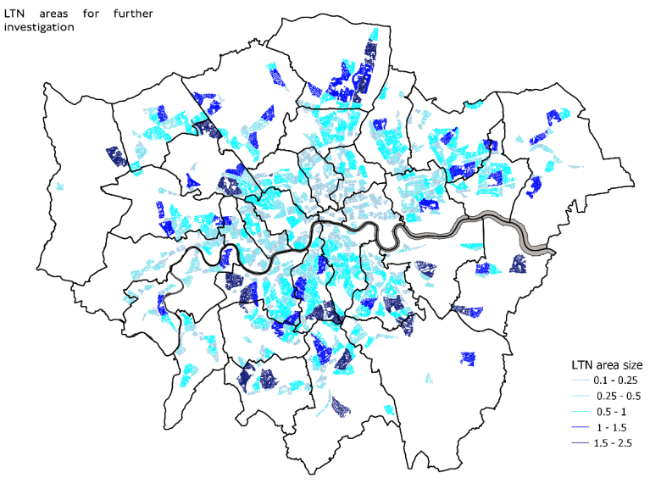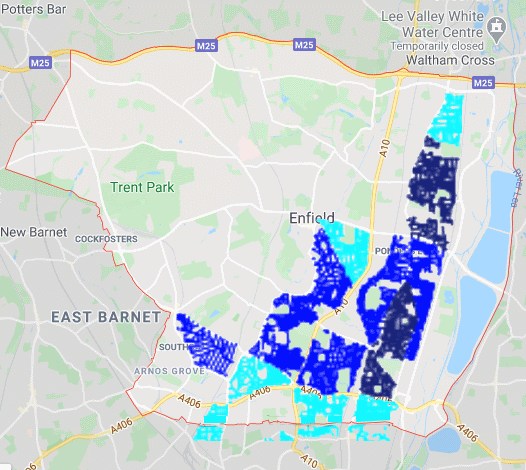
Some boroughs started taking action last month, such as this pavement widening work in Herne Hill (Lambeth)
In order to be able to live with reduced public transport capacity, provide space for social distancing even after the end of lockdown, and avoid a return to traffic-snarled roads and unhealthy air, the government has told local authorities that it expects them to take urgent measures to reallocate roadspace away from cars to provide more room for walking and cycling "as swiftly as possible, and in any event within weeks".
Measures are to include "pop-up" cycle lanes with light segregation features, more school streets, lower speed limits, pedestrian and cycle zones that exclude motor traffic, low-traffic residential neighbourhoods, and bus and cycle corridors along key routes into town and city centres.
Enfield Council's '"Streetspace Plan", announced last week, will incorporate measures of this sort - residents are able to upload their own suggestions to the council's Consultation Hub.
A "new world": millions more cycling and more space for pedestrians
The measures to reallocate roadspace are specified in statutory guidance published on 9th May. In the foreword the secretary of state for transport, Grant Shapps, writes that "With public transport capacity reduced, the roads in our largest cities, in particular, may not be able to cope without [millions more cycling]" and that "in the new world, pedestrians will need more space. Indications are that there is a significant link between COVID-19 recovery and fitness. Active travel can help us become more resilient."
The government, he writes, "expects local authorities to make significant changes to their road layouts to give more space to cyclists and pedestrians" to "help embed altered behaviours and demonstrate the positive effects of active travel".
What measures does the government specify?
The statutory guidance says that travel habits need to be changed before the post-lockdown "restart" takes full effect and measures are to include:
- Installing "pop-up" cycle facilities with a minimum level of physical separation from volume traffic; for example, mandatory cycle lanes, using light segregation features such as flexible plastic wands; or quickly converting traffic lanes into temporary cycle lanes (suspending parking bays where necessary); widening existing cycle lanes to enable cyclists to maintain distancing. Facilities should be segregated as far as possible, i.e. with physical measures separating cyclists and other traffic. Lanes indicated by road markings only are very unlikely to be sufficient to deliver the level of change needed, especially in the longer term.
- Using cones and barriers: to widen footways along lengths of road, particularly outside shops and transport hubs; to provide more space at bus stops to allow people to queue and socially distance; to widen pedestrian refuges and crossings (both formal and informal) to enable people to cross roads safely and at a distance.
- Encouraging walking and cycling to school, for example through the introduction of more ‘school streets’. Pioneered in London, these are areas around schools where motor traffic is restricted at pick-up and drop-off times, during term-time. They can be effective in encouraging more walking and cycling, particularly where good facilities exist on routes to the school and where the parents, children and school are involved as part of the scheme development.
- Reducing speed limits: 20mph speed limits are being more widely adopted as an appropriate speed limit for residential roads, and many through streets in built-up areas. 20mph limits alone will not be sufficient to meet the needs of active travel, but in association with other measures, reducing the speed limit can provide a more attractive and safer environment for walking and cycling.
- Introducing pedestrian and cycle zones: restricting access for motor vehicles at certain times (or at all times) to specific streets, or networks of streets, particularly town centres and high streets. This will enable active travel but also social distancing in places where people are likely to gather.
- Modal filters (also known as filtered permeability); closing roads to motor traffic, for example by using planters or large barriers. Often used in residential areas, this can create neighbourhoods that are low-traffic or traffic free, creating a more pleasant environment that encourages people to walk and cycle, and improving safety.
- Providing additional cycle parking facilities at key locations, such as outside stations and in high streets, to accommodate an increase in cycling, for example by repurposing parking bays to accommodate cycle racks.
- Changes to junction design to accommodate more cyclists – for example, extending Advanced Stop Lines at traffic lights to the maximum permitted depth of 7.5 metres where possible.
- "Whole-route" approaches to create corridors for buses, cycles and access only on key routes into town and city centres.
- Identifying and bringing forward permanent schemes already planned, for example under Local Cycling and Walking Infrastructure Plans, and that can be constructed relatively quickly.
Source: www.gov.uk/government/publications/reallocating-road-space-in-response-to-covid-19-statutory-guidance-for-local-authorities/traffic-management-act-2004-network-management-in-response-to-covid-19
Traffic Regulation Orders - not always needed
The guidance says that some measures, such as new lightly segregated cycle lanes, can be introduced without the need for Traffic Regulation Orders (TROs). For cases where they are required, it discusses the pros and cons of the different types of TRO:
Challenge to use of experimental Traffic Regulation Orders for A105 cycle lanes rejected

Winchmore Hill Residents Association called for the removal of this stretch of cycle lane to allow more parking
Experimental TROs - used to trial arrangements with a view to making them permanent - were used by Enfield Council to restrict parking along some stretches of the A105 cycle lanes. The consultation on the A105 TROs ran until July 2019 and a report on the responses received and decisions taken was recently published on the council website. Four of the six experimental traffic orders have been made permanent, while the remaining two have been modified in response to consultation feedback, meaning that a further six-month consultation period was required (this ends on 3rd June).
The use of experimental TROs along the cycle lanes route was challenged by opponents of the cycle lanes scheme, notably Save Our Green Lanes and Winchmore Hill Residents Association. The latter called, unsuccessfully, for restoration of parking on the west side of Green Lane between Compton Road and Station Road and removal of the cycle lanes on one side of the road along this stretch.

 Enfield residents have already made many proposals for reallocating roadspace using this "ideas map"
Enfield residents have already made many proposals for reallocating roadspace using this "ideas map"






